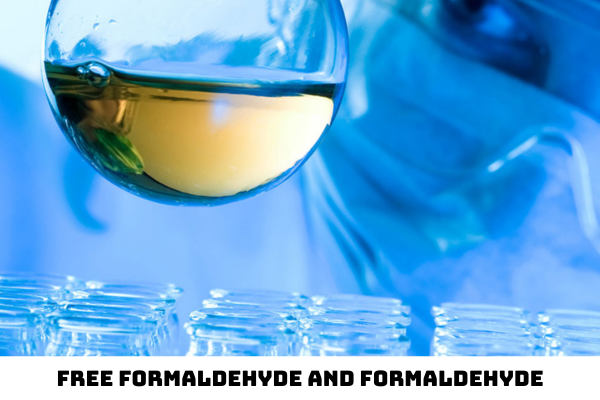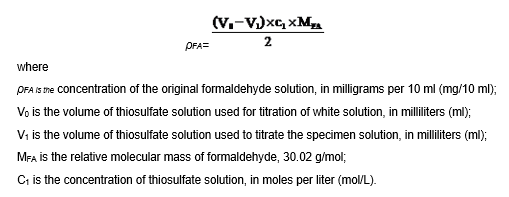What are the regulations on reagents, equipment, and instruments used in determining free formaldehyde and formaldehyde under Vietnam Standard TCVN 7535-1: 2010?
- What are the regulations on reagents used in determining free formaldehyde and formaldehyde under Vietnam Standard TCVN 7535-1: 2010?
- What are the regulations on equipment and instruments used in determining free formaldehyde and formaldehyde under Vietnam Standard TCVN 7535-1: 2010?
- What are the instructions for determining free formaldehyde and released formaldehyde in the skin according to the Vietnam Standard TCVN 7535-1: 2010?
What are the regulations on reagents used in determining free formaldehyde and formaldehyde under Vietnam Standard TCVN 7535-1: 2010?
Under Section 5 of the Vietnam Standard TCVN 7535-1: 2010 on reagents as follows:
Use only reagents with known levels of analysis, unless otherwise specified. Water must be category 3 according to TCVN 4851: 1989 (ISO 3696: 1987). All solutions are aqueous solutions.
- Reagents for the original formaldehyde solution
+ Formaldehyde solution, about 37% (mass fraction).
+ Iodine solution, 0.05 mol/l, that is, 12.68 g of iodine per liter.
+ Sodium hydroxide solution, 2.0 mol/l.
+ Sulfuric acid solution, 2.0 mol/l.
+ Sodium thiosulfate solution, 0.1 mol/l.
+ Starch lake solution, 1 %, that is, 1 g of starch in 100 ml of water.
- Reagents for method using high performance liquid chromatography
+ Sodium dodecylsulphonate solution (bleach), 0.1 %, 1 g in 1000 ml of water.
+ Dinitrophenylhydrazine solution, consisting of 0.3 g dinitrophenylhydrazine (2,4-dinitrophenylhydrazine) dissolved in 100 ml of concentrated o-phosphoric acid (85 % by mass). (dinitrophenylhydrazine is recrystallized from 25 percent by mass, acetonitrile in water)
+ Axetonitril
What are the regulations on equipment and instruments used in determining free formaldehyde and formaldehyde under Vietnam Standard TCVN 7535-1: 2010?
Under Section 6 of the Vietnam Standard TCVN 7535-1: 2010, the equipment and instruments used in determining free formaldehyde and formaldehyde arre specified as follows:
Use common laboratory equipment, especially the following equipment and instruments.
- Rated bottles, capacities of 10 ml, 500 ml, and 1000 ml.
- Erlenmeyer vials, capacity 100 ml and 250 ml.
- Filter hopper with fiberglass filter, GF8 (or G3 glass filter hopper, diameter from 70 mm to 100 mm).
- Water insulation device, controlling thermostatic to 40 0C ± 0.5 0C, mounted with shaker or stirrer of the vessel.
- Thermometer, graduated to 0.1 0C between 20 0C and 50 0C.
- High performance liquid chromatography system with UV probe, 360 nm.
- Membrane, polyamide, 0.45 μm.
- Analytical weighing, weighing accurate to 0.1 m

What are the instructions for determining free formaldehyde and released formaldehyde in the skin according to the Vietnam Standard TCVN 7535-1: 2010?
In Section 7 of the Vietnam Standard TCVN 7535-1: 2010, the instructions for determining free formaldehyde and released formaldehyde in the skin are specified as follows:
* Procedures for determining formaldehyde in the original solution
(1) Preparation of original formaldehyde solution
Use a pipette to remove 5 ml of formaldehyde solution (5.1.1) into a 1000 ml (6.1) rated jar containing about 100 ml of water and then add demineralized water to the level mark. This solution is the original formaldehyde solution.
(2) Determination
Use a pipette to take 10 ml of original formaldehyde solution into a 250 ml (6.2) Erlenmeyer jar and mix it with 50 ml of iodine solution (5.1.2). Add sodium hydroxide (5.1.3) until the mixture turns yellow. Let the mixture react for 15 min ± 1 min at 18 0C to 26 0C and then stir the mixture while adding 15 ml of sulfuric acid (5.1.4).
After adding 2 ml of starch paste solution (5.1.6), titrate the residual iodine together with sodium thiosulfate (5.1.5) until discoloration. Conduct three separate identifications. Titrate at least two white solutions in a similar way.

* Procedures for determining formaldehyde in the skin by method using high performance liquid chromatography
(1) Sampling and sample preparation
If possible, take samples according to TCVN 7117 (ISO 2418). If sampling according to TCVN 7117 (ISO 2418) cannot be taken (e.g., leather taken from finished products such as shoes or clothing), the details of the sampling must be stated in the test report.
Crush skin according to TCVN 7126 (ISO 4044).
If the results are based on dry matter, add a test sample of the same skin type according to ISO 4684 so that the moisture content can be calculated.
(2) Extraction
Weigh 2 g ± 0.1 g of skin put in a suitable jar. Using a pipette, take 50 ml of bleach solution (5.2.1) into a 100 ml (6.2) Erlenmeyer jar and heat the solution to 40 0C. Transfer the amount of pre-weighed skin to the jar, then cover tightly with a glass stopper (see below). Stir the mixture in a jar or shake gently at 40 0C ± 0.5 0C on a water insulator (6.4) for 60 min ± 2 min. The heated extraction solution is vacuum-filtered right through the glass filter hopper (6.3) and then put into the jar. Cool the filtrate solution in a sealed vessel to room temperature (18 0C to 26 0C).
Do not change the skin/solution ratio. The extraction and analysis must be carried out on the same day.
(3) Reaction to dinitrophenylhydrazin
Use a pipette to place 4.0 ml of acetonitril (5.2.3), 5.0 ml of fraction of filtered defecation rinse (7.2.2) and 0.5 ml of dinitrophenylhydrazin solution (5.2.2) into a 10 ml rated vessel (6.1). Pour more demineralized water into the rated vessel to the level mark and shake it quickly with your hands to mix the mixture well.
Let the mixture stand at least 60 min, but no more than 180 min. After filtration through the membrane (6.7), analyze the sample according to the method using high performance liquid chromatography. If the concentration of the sample is outside the calibration interval, then take the smaller fraction.
(4) High performance liquid chromatography conditions (recommended)
High performance liquid chromatography conditions are recommendations only. The method used must be tested using the recovery rate determination (7.2.7) and the observed results must be within the range listed in Table A.1.
Flow rate: 1.0 ml/min
Dynamic phase: acetonitrium/water, 60:40
Split column: C18 reverse phase column with preliminary separation column (1 cm, RP18)
UV wavelength for detection: 360 nm
Pump volume: 20 μl
Note: Merck 100 column, CH 18.2 (thickly coated, 12%C) is an example of a suitable split column that can be purchased1)
(5) High performance liquid chromatography calibration
Use a pipette, take 0.5 ml of the original formaldehyde solution obtained according to 7.1.1, with an exact known formaldehyde content, and put it in a 500 ml (6.1) rated jar with approximately 100 ml of water available. Mix well and add water to the level mark, and mix well again. This solution is a calibration solution, that is, a standard solution, containing about 2 μg of formaldehyde/ml.
Add 4 ml of acetonitril (5.2.3) to each of six 10 ml (6.1) rated vessels, then, to create a concentration range, add 0.5 ml of standard solution to each jar; 1.0 ml; 2.0 ml; 3.0 ml; 4.0 ml; 5.0 ml. Immediately after adding formaldehyde solution (5.1.1), mix each jar well and add 0.5 ml of DNPH solution (5.2.2). Add demineralized water to the jars to the level mark and mix well. After at least 60 min and no more than 180 min, analyze the sample by method using high performance liquid chromatography after filtration (6.7).
Perform calibration by plotting a graph of the formaldehyde derivative pic area corresponding to the concentration in micrograms per 10 ml.
(6) Calculation of formaldehyde content in the test sample

(7) Sampling - Determination of recovery rate
First pour 4 ml of acetonitril (5.2.3) into a 10 ml (6.1) rated jar and add the estimated fraction of the resulting 2.5 ml of filtrate solution as described in 7.2.2. Then add an amount of precisely defined formaldehyde standard solution to obtain a concentration roughly equivalent to the concentration identified in the test sample.
Further treatment of this solution follows the procedure described in 7.2.3 and defines ρs2 according to the procedure described in 7.2.3.
Proceed to determine and record this value in the test report.

LawNet